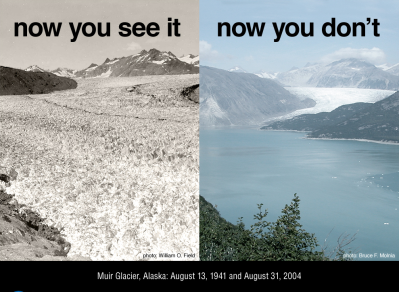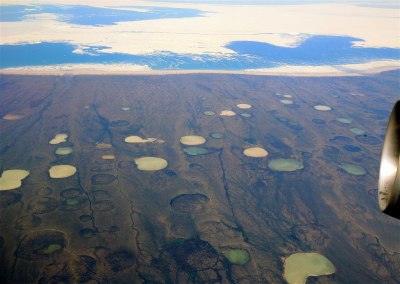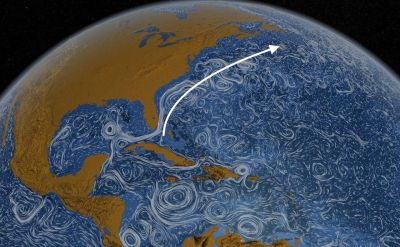Science
Tipping Points In The Climate System: The Worst Kind Of Positive Feedback – Hackaday

With global temperatures continuing to break records in recent years, it’s important to cast an eye towards the future. While efforts to reduce emissions remain in a political quagmire, time is running out to arrest the slide into catastrophe.
Further compounding the issue are a variety of positive feedback loops that promise to further compound the problem. In these cases, initial warming has flow-on effects that then serve to further increase global temperatures. Avoiding these feedback mechanisms is crucial if the Earth is to remain comfortably livable out to the end of the century.
A Multitude of Causes
The issue of climate change often appears as a simple one, with the goal being to reduce greenhouse gas emissions in order to prevent negative consequences for human civilization. Despite this, the effects of climate change are often diffuse and intermingled. The various climate systems of the Earth interact in incredibly complex ways, and there are many mechanisms at play in these feedback effects that could tip things over the edge.
Ice-Albedo


The ice-albedo feedback mechanism is a climate process in which the amount of ice on earth has a significant effect on global temperature changes. It’s a positive feedback relationship, meaning it has the possibility of causing a runaway effect if not managed carefully. Higher global temperatures cause sea ice, land ice, and glaciers to melt. The ice, which is highly reflective, is instead replaced with open water, or land, which is less reflective, having a lower albedo. This causes the Earth to retain more heat from solar radiation, instead of reflecting it back into space. This further raises temperatures, causing more ice to melt, creating the positive feedback effect.
Ice levels around the world are an active target of study for climate scientists. Records show major sustained losses over recent decades to major ice sheets, and glaciers are retreating all over the world. These areas, formerly covered in highly reflective ice, are now absorbing more heat than ever from solar radiation. As temperatures continue to rise, it’s likely that ice packs around the world will continue to thaw, further exacerbating the effect.
Methane Releases From Not-So-Permafrost


Another major concern of climate scientists is the possibility of large-scale releases of methane and other greenhouse gases into the atmosphere from a variety of environmental sources. Areas such as Western Siberia have large reserves of methane trapped under permafrost, while significant reserves exist under the oceans, too. As the climate warms, much of this permafrost is beginning to thaw, releasing the stored methane trapped below the surface. This has the effect of further increasing warming, as methane is a potent greenhouse gas, with a warming potential over 20 times that of CO2 over a 20 year time frame.
There is significant worry that a tipping point could be reached in which there is an abrupt release of large amounts of methane from these sources, causing a rapid increase in global temperatures. In this event, reducing human emissions would do little to help, as the released greenhouse gases can not simply be returned to the soil. Research is ongoing to produce models to predict what will happen in the event of further thawing of formerly-permanent permafrost. There is some hope — slower thawing seems likely to reduce the amount of harmful greenhouse gases released, as plants grow in formerly frozen areas, once again locking up carbon. Faster thaws threaten more massive, abrupt releases, which are more likely to result in rapid temperature rise.
Ocean Current Slowdown


The world’s oceans are a major player in the climate system. Acting as a giant heat sink, what happens in the oceans tends to have staggering effects on weather patterns everywhere. Major ocean currents are a large part of this mechanism, responsible for transporting huge amounts of heat stored in these waters around the globe.
Scientists have been monitoring changes in ocean currents, and have observed major changes in recent years. The Gulf Stream is one such current, which has often been linked to major climate events in the distant past. It’s slowing down, and is currently weaker than at any point in the last 1600 years. The weakening is unprecedented, and current research suggests the change is at least in part due to human-induced climate change. The effect is multifaceted, with temperature increases and freshwater from melting sea ice both playing a role.
Many theorize that a slowdown or shutdown of ocean currents could have major consequences on the world climate. Extreme warming or cooling could occur in different areas, and storm activity, such as hurricanes, could increase in both frequency and magnitude. Research suggests that changes in these currents can be both an indicator and driver of climate shifts, and it’s likely that ocean currents will continue to change as anthropogenic warming continues.
Forest Loss And Fires


Forests are an important player in the global climate, acting as a major carbon dioxide sink. However, in recent years, increased temperatures and extreme wildfires have led to large swathes of forests dying off or simply going up in smoke. As trees die and are broken down by microbes, or as they burn up in fires, this leads to releases of greenhouse gases. This causes further warming, compounding the problem in yet another example of positive feedback.
Wildfires are becoming worse and more frequent. Last year’s Arctic wildfires released a massive volume of CO2 in June alone — equal to Sweden’s annual total output. After facing its hottest and driest year on record in 2019, Australia also faced its worst recorded fire season, with over 10 million hectares burned. These fires grew large enough to create their own weather, with Pyrocumulonimbus clouds observed forming from the smoke and causing lightning storms which spawned further fires in other areas. This is a case of positive feedback in the very short term, with large fires creating further fires due to the harsh conditions.
Forest die-offs have their own consequences, too. Boreal forests are shrinking, thus acting as less of a carbon sink as tree numbers begin to dwindle. As the forests thin out, conditions get warmer and dryer for remaining trees, further accelerating the decline. This also leads to issues as other species, both flora and fauna, have to adapt as tree cover shrinks and conditions change.
What Can Be Done?
The aforementioned feedback mechanisms are all current areas of research for climate scientists around the globe. The topic of abrupt and sudden climate change is only loosely understood. Most existing climate models are based on steady, gradual changes to the climate from human activity. These models don’t account for the possibility of large sudden methane releases from formerly frozen soils, or mass releases of carbon dioxide from continental-scale wildfires.
Unfortunately, the mechanisms at play in these feedback scenarios are far beyond the scale that humanity can realistically arrest. The only real mechanism with which to play with is the output of greenhouse gases from human activities. By reigning in emissions, there is a possibility that humanity still has time to avoid triggering these tipping points. Only time will tell.
Science
SpaceX launch marks 300th successful booster landing – Phys.org


SpaceX sent up the 30th launch from the Space Coast for the year on the evening of April 23, a mission that also featured the company’s 300th successful booster recovery.
A Falcon 9 rocket carrying 23 of SpaceX’s Starlink internet satellites blasted off at 6:17 p.m. Eastern time from Cape Canaveral Space Force Station’s Space Launch Complex 40.
The first-stage booster set a milestone of the 300th time a Falcon 9 or Falcon Heavy booster made a successful recovery landing, and the 270th time SpaceX has reflown a booster.
This particular booster made its ninth trip to space, a resume that includes one human spaceflight, Crew-6. It made its latest recovery landing downrange on the droneship Just Read the Instructions in the Atlantic Ocean.
The company’s first successful booster recovery came in December 2015, and it has not had a failed booster landing since February 2021.
The current record holder for flights flew 11 days ago making its 20th trip off the launch pad.
SpaceX has been responsible for all but two of the launches this year from either Kennedy Space Center or Cape Canaveral with United Launch Alliance having launched the other two.
SpaceX could knock out more launches before the end of the month, putting the Space Coast on pace to hit more than 90 by the end of the year, but the rate of launches by SpaceX is also set to pick up for the remainder of the year with some turnaround times at the Cape’s SLC-40 coming in less than three days.
That could amp up frequency so the Space Coast could surpass 100 launches before the end of the year, with the majority coming from SpaceX. It hosted 72 launches in 2023.
More launches from ULA are on tap as well, though, including the May 6 launch atop an Atlas V rocket of the Boeing CST-100 Starliner with a pair of NASA astronauts to the International Space Station.
ULA is also preparing for the second launch ever of its new Vulcan Centaur rocket, which recently received its second Blue Origin BE-4 engine and is just waiting on the payload, Sierra Space’s Dream Chaser spacecraft, to make its way to the Space Coast.
Blue Origin has its own rocket it wants to launch this year as well, with New Glenn making its debut as early as September, according to SLD 45’s range manifest.
2024 Orlando Sentinel. Distributed by Tribune Content Agency, LLC.
Citation:
SpaceX launch marks 300th successful booster landing (2024, April 24)
retrieved 24 April 2024
from https://phys.org/news/2024-04-spacex-300th-successful-booster.html
This document is subject to copyright. Apart from any fair dealing for the purpose of private study or research, no
part may be reproduced without the written permission. The content is provided for information purposes only.
Science
Wildlife Wednesday: loons are suffering as water clarity diminishes – Canadian Geographic


The common loon, that icon of northern wilderness, is under threat from climate change due to declining water clarity. Published earlier this month in the journal Ecology, a study conducted by biologists from Chapman University and Rensselaer Polytechnic Institute in the U.S. has demonstrated the first clear evidence of an effect of climate change on this species whose distinct call is so tied to the soundscape of Canada’s lakes and wetlands.
Through the course of their research, the scientists found that July rainfall results in reduced July water clarify in loon territories in Northern Wisconsin. In turn, this makes it difficult for adult loons to find and capture their prey — mainly small fish — underwater, meaning they are unable to meet their chicks’ metabolic needs. Undernourished, the chicks face higher mortality rates. The consistent foraging techniques used by loons across their range means this impact is likely echoed wherever they are found — from Alaska to Canada to Iceland.
The researchers used Landsat imagery to find that there has been a 25-year consistent decline in water clarity, and during this period, body weights of adult loon and chicks alike have also declined. With July being the month of most rapid growth in young loons, the study also pinpointed water clarity in July as being the greatest predictor of loon body weight.
One explanation for why heavier rainfall leads to reduced water clarity is the rain might carry dissolved organic matter into lakes from adjacent streams and shoreline areas. Lawn fertilizers, pet waste and septic system leaks may also be to blame.
The researchers, led by Chapman University professor Walter Piper, hope to use these insights to further conservation efforts for this bird Piper describes as both “so beloved and so poorly understood.”
Return of the king
Science
Giant prehistoric salmon had tusk-like teeth for defence, building nests


|
|
The artwork and publicity materials showcasing a giant salmon that lived five million years ago were ready to go to promote a new exhibit, when the discovery of two fossilized skulls immediately changed what researchers knew about the fish.
Initial fossil discoveries of the 2.7-metre-long salmon in Oregon in the 1970s were incomplete and had led researchers to mistakenly suggest the fish had fang-like teeth.
It was dubbed the “sabre-toothed salmon” and became a kind of mascot for the Museum of Natural and Cultural History at the University of Oregon, says researcher Edward Davis.
But then came discovery of two skulls in 2014.
Davis, a member of the team that found the skulls, says it wasn’t until they got back to the lab that he realized the significance of the discovery that has led to the renaming of the fish in a new, peer-reviewed study.
“There were these two skulls staring at me with sideways teeth,” says Davis, an associate professor in the department of earth sciences at the university.
In that position, the tusk-like teeth could not have been used for biting, he says.
“That was definitely a surprising moment,” says Davis, who serves as director of the Condon Fossil Collection at the university’s Museum of Natural and Cultural History.
“I realized that all of the artwork and all of the publicity materials and bumper stickers and buttons and T-shirts we had just made two months prior, for the new exhibit, were all out of date,” he says with a laugh.
Davis is co-author of the new study in the journal PLOS One, which renames the giant fish the “spike-toothed salmon.”
It says the salmon used the tusk-like spikes for building nests to spawn, and as defence mechanisms against predators and other salmon.
The salmon lived about five million years ago at a time when Earth was transitioning from warmer to relatively cooler conditions, Davis says.
It’s hard to know exactly why the relatives of today’s sockeye went extinct, but Davis says the cooler conditions would have affected the productivity of the Pacific Ocean and the amount of rain feeding rivers that served as their spawning areas.
Another co-author, Brian Sidlauskas, says a fish the size of the spike-toothed salmon must have been targeted by predators such as killer whales or sharks.
“I like to think … it’s almost like a sledgehammer, these salmon swinging their head back and forth in order to fend off things that might want to feast on them,” he says.
Sidlauskas says analysis by the lead author of the paper, Kerin Claeson, found both male and female salmon had the “multi-functional” spike-tooth feature.
“That’s part of our reason for hypothesizing that this tooth is multi-functional … It could easily be for digging out nests,” he says.
“Think about how big the (nest) would have to be for an animal of this size, and then carving it out in what’s probably pretty shallow water; and so having an extra digging tool attached to your head could be really useful.”
Sidlauskas says the giant salmon help researchers understand the boundaries of what’s possible with the evolution of salmon, but they also capture the human imagination and a sense of wonder about what’s possible on Earth.
“I think it helps us value a little more what we do still have, or I hope that it does. That animal is no longer with us, but it is a product of the same biosphere that sustains us.”
This report by The Canadian Press was first published April 24, 2024.
Brenna Owen, The Canadian Press





-



 Politics21 hours ago
Politics21 hours agoOpinion: Fear the politicization of pensions, no matter the politician
-



 Politics20 hours ago
Politics20 hours agoPecker’s Trump Trial Testimony Is a Lesson in Power Politics
-



 Science20 hours ago
Science20 hours agoNASA Celebrates As 1977’s Voyager 1 Phones Home At Last
-
Media19 hours ago
B.C. puts online harms bill on hold after agreement with social media companies
-
Media13 hours ago
B.C. online harms bill on hold after deal with social media firms
-
Business19 hours ago
Oil Firms Doubtful Trans Mountain Pipeline Will Start Full Service by May 1st
-
Media18 hours ago
Trump poised to clinch US$1.3-billion social media company stock award
-
Art22 hours ago
Turner Prize: Shortlisted artist showcases Scottish Sikh community




